If you are planning to undergo hip replacement surgery – or if you have already had your hip replaced – this brochure may help you to understand how your rehabilitation programme can help you to prepare for your surgery, as well as guide you in your recovery process so that you can return to your active, independent lifestyle more quickly.
If you have had a hip replacement in the last few months, you may find some useful tips and reminders on how to perform daily tasks and hasten your recovery.
HOW CAN I IMPROVE MY PHYSICAL CONDITION PRIOR TO HIP REPLACEMENT SURGERY?
Prior to a planned hip replacement surgery, it’s important to improve your physical condition. To be fit and in the best shape for a successful surgery, your surgeon recommends that you:
- Stop smoking and drinking alcohol,
- Stay active to keep your heart healthy,
- Exercise with your physiotherapist to improve your condition, muscle strength, reduce your pain and learn to walk with crutches,
- Reduce your weight with help from your dietician and eat a well-balanced diet.
HOW SHOULD I PREPARE MY HOME FOR A SAFE RETURN FOLLOWING SURGERY?
In the few first weeks following your surgery, your mobility will be limited. Prior to having the surgery, you should prepare your home return environment by eliminating all potential hazards and obstacles to prevent accidents or falls:
- Remove carpets, rugs and cables from the floor,
- Ensure no floor in your bathroom or kitchen is slippery
- Ensure that your toilet seat is high enough to keep your hips higher than your knees,
- Organise your kitchen so that you can cook in a standing position,
- Avoid storing essential items on the floor or in low cupboards, especially in the kitchen or bedroom,
- Ensure that you have comfortable chair to sit in,
- Prepare a bed on the lowest floor of your house so that you don’t need to negotiate stairs when you first return home after surgery,
- Wear easy-to-put on rubber-soled shoes to prevent you from slipping.
WHY WILL I NEED REHABILITATION AFTER HIP REPLACEMENT SURGERY?
Rehabilitation starts soon after your surgery and helps you to return safely to your independent, active lifestyle. The physiotherapist will help you to manage pain effectively, strengthen your muscles and improve your gait, your mobility and your ability to perform daily tasks by yourself.
During your rehabilitation programme, you will also learn how to protect your hip while developing a customized exercise programme.
WHEN SHOULD I START REHABILITATION AFTER SURGERY?
When you undergo surgery, your surgeon will talk to you about starting daily inpatient rehabilitation with your physiotherapist. The first steps in your rehabilitation include:
- Establishing comfortable, safe positions,
- Controlling your pain and swelling,
- Being able to stand and take your first steps with a walking aid,
- Learning movements to prevent hip dislocation,
- Learning how to organise your environment for safe mobility,
- Improving your joint mobility and muscle strength,
- Learning to walk with walking aids and how to negotiate stairs to prepare for your return home.
After being discharged from the hospital, your surgeon may recommend that you continue a follow-up rehabilitation programme with your physiotherapist. Based on your physical condition, a few sessions are usually required before you gain complete recovery of your gait mechanics without walking aids.
HOW SHOULD I COPE WITH PAIN?
Prior to and after the surgery, your physiotherapist will help you to control your pain through a wide range of medication-free techniques such as:
- Ice therapy and ice compressive therapy,
- Leg positioning, stretching and exercising,
- Active joint mobilisation,
- Transcutaneous Electro Neuro Stimulation (TENS).
WHAT CAN I DO TO HASTEN MY RECOVERY?
Your recovery will progress day-by-day and your physiotherapist will guide you in your rehabilitation process. Meanwhile, you should:
- Avoid any strenuous activities,
- Avoid any positions or movements prohibited by your surgeon and your physiotherapist,
- Exercise as recommended by your physiotherapist, ensuring you do not over exercise,
- Control your pain and swelling by elevating your leg and by following your ice programme,
- Walk as recommended,
- Avoid standing or sitting in one position for long periods, instead taking short and frequent walks,
- Use compressive socks as recommended by your surgeon.
You are at risk of falling until you have gained complete recovery of your leg function. Do not perform activities such as getting out of bed and going up and down the stairs by yourself if not recommended to do so.
IS THERE A RISK OF HIP DISLOCATION FOLLOWING HIP REPLACEMENT SURGERY?
The risk of hip dislocation following hip replacement is high during the three first months, then, the risk will decrease progressively as you continue to strengthen the muscles around your hip and naturally avoid all prohibited movements.
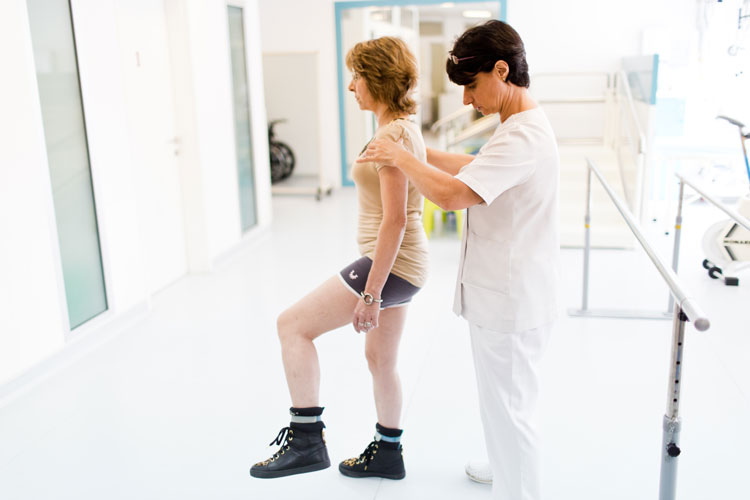
HOW CAN I AVOID HIP DISLOCATION FOLLOWING HIP REPLACEMENT SURGERY?
To avoid dislocating your hip, you will need to take several precautions:
- When sitting or leaning forward and bending from your hip, the angle of your hip must not exceed 90 degrees,
- Do not turn your operated leg inward,
- Do not cross your operated leg over or under your non-operative leg, either at the knee or ankle.
1. While in a lying position and when sleeping
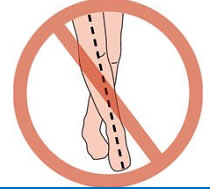
When lying on your back:
DO NOT cross your legs.


DO NOT sleep on your non-operative side with your operated leg pointed inward.
DO: Use a pillow between your knees to sleep on your non-operative side.
When getting into or out of bed:
DO NOT:
– Twist your operated leg,
– Sit on the edge of your bed with your buttocks lower than your knees.
DO:
– Get out of bed on your operated side, keeping your thighs apart. With your healthy leg, gradually scoot to the edge of the bed. Keep your legs straight and apart, pushing your body up with your hands behind your hips.
– Get into bed by sliding down onto the bed on your healthy side, keeping your thighs apart. Sit on the edge of your bed, keeping your hips forward and legs straight while using your hands to manoeuvre yourself onto the bed. Lower yourself down.
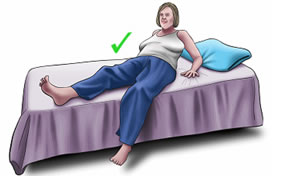
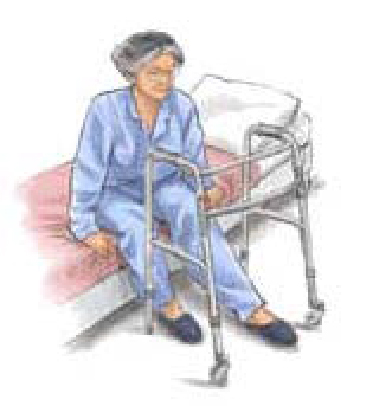
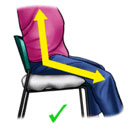
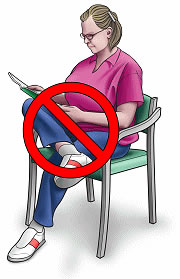
2. In a sitting position
DO always sit with your hips higher than your knees. Placing a firm pillow on the seat of a chair can help.
DO NOT bend your operated hip more than 90 degrees.
DO NOT squat.
DO NOT cross your operated leg over or under your non-operative leg.
3. When sitting down and standing up
To stand from a sitting position, grasp your armrests, sit at the edge of your chair, bend your non-operative leg under your seat, slide your operated leg forward and push up on your hands.
To sit from a standing position, move backwards until you touch the chair, slide your operated leg forwards, grab the armrests and bend your non-operative leg, lowering yourself into the seat.
DO NOT bend your body forward when getting up or sitting down.
4. In a standing position
DO:
– Turn both feet and your body at the same time,
– Use the walking aids as recommended by your physiotherapist.
DO NOT twist your operated leg inwards while putting your weight on it, especially when turning your body.
DO NOT bend your body to pick up items on the floor.
DO:
– Use a grabber to pick up objects from the floor without bending over,
– Use a long handled shoehorn to slide your heels into your shoes,
– Use a long handled sponge or brush to wash your feet.
5. Daily activities
Using the restroom
– Use an elevated toilet seat to keep your hips higher than your knees,
– Install a grab bar next to the toilet for support when sitting down and standing up.
Bathing
– Use a shower bench or chair while bathing to prevent you from bending forward too far,
– Install grab bars in your shower or on your bathtub to support you as you get in or out,
– Use a long handled sponge and shower hose for cleaning your feet,
– Ask other people for help caring for your toenails.
Dressing
DO NOT lean forward to reach for clothing, or to put on your pants or shoes.
DO:
– Use a sock-aid or long handled shoehorn to avoid bending your operated hip while sitting,
– Ask for help or use assistive devices to put on pants and underwear.
When driving a car or motorbike
To get into a car:
– Push the seat of your car as far back as possible,
– Sit down while sliding your leg forwards,
– Slide down into a half lying position while turning your legs and your body at the same time.
To be safe, ask your doctor when you can return to driving a car or a motorbike.
WHEN SHOULD I CONTACT MY PHYSIOTHERAPIST?
At any point during or after your rehabilitation programme, please do not hesitate to contact your physiotherapist when:
- Your hip pain increases after exercising,
- Your leg swells after exercising,
- You cannot practice exercises as recommended by your physiotherapist,
- You plan or would like to challenge yourself with a new physical activity,
- Your hip feels more stiff or more uncomfortable than usual,
- You need advice performing routine activities.
For further information, please contact
FV Hospital – Physiotherapy & Rehabilitation Department
F Building, 1st floor
Call direct line (028) 54 11 33 40
Or FVH’s main line (028) 35 11 33 33, and extension: 1085 or 1485
Email: rehabilitation@fvhospital.com



